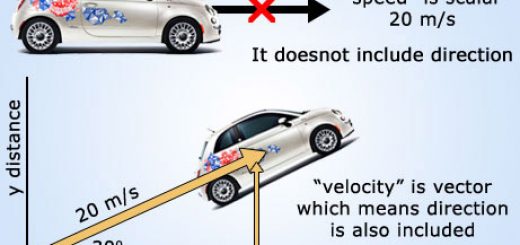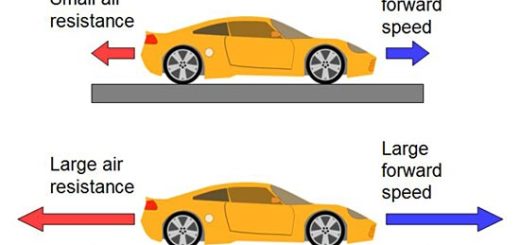Light refraction effects, Law of light refraction, Mirage and Apparent positions of objects
The light refracts when it travels from a medium to another due to the difference of light velocity through the difference transparent media, Occurrence of mirage phenomenon in desert regions at noon due to the reflection and refraction of light in air layers which differ in the degree of temperature.
Light refraction
When you push a barrel from asphalt to sand then to asphalt again, the barrel changes its path, this is due to the change of barrel velocity on asphalt from that on the sand, Similarly, as light travels from a transparent medium (like air) to another transparent medium (like grass). Its path changes due to the difference in the velocity of light through different transparent media and this phenomenon is known as “Light refraction“.
Light refraction is the change of light path when it travels from a transparent medium to another transparent medium of different optical densities. The ability of the transparent medium to refract light is called the “optical density of the medium” Optical density of the medium is the ability of the transparent medium to refract light.
Each medium has its own optical density, So the optical density of a medium differs from one medium to another, which leads to the change in the light velocity through such medium, i.e. As the Optical density of the medium increases, the speed of light through it decreases and vice versa. The velocity of light changes from one medium to another, because the optical density of a medium differs from one medium to another.
Concepts related to light refraction
- The angle of incidence is the angle between the incident light ray and the normal at the point of incidence on the interface.
- The angle of refraction is the angle between the refracted light ray and the normal at the point of incidence on the interface.
- The angle of emergence is the angle between the emergent light ray and the normal at the point of emergence on the interface.
When the angle of emergence in a prism is 50°, This means that the angle between the emergent light ray and the line perpendicular to the interface at the point of emergence is 50°.
Put a rectangular glass block on a white paper sheet and mark around the block using a pensil. Direct a ray from the laser pen to the point of incidence (A) on the side of the rectangular glass and draw its pass (using the pencil and the ruler) to represent the incident ray. Draw the path of the emergent ray from point (B) on the opposite side of the glass.
Remove the rectangular glass and join the two points (A) and (B) with a straight line that represents the refracted ray. Draw at (A) and (B) dotted vertical lines. where it represents the normal at the point of incidence and at the point of emergence on the interface.
You observe that: when the light ray travels from air into a glass or vice versa, it refracts. The angle of incidence is not equal to the angle of refraction. The angle of incidence is equal to the angle of emergence. The incident light ray is parallel to the emergent light ray. so, the light refraction phenomenon occurs when the light ray travels from a transparent medium to another transparent medium of different optical densities.
Law of light refraction
The path of a light ray falls on the interface between two transparent media differ in their optical densities:
- When a light ray travels from a transparent medium of lower optical density (like air or water) to another of higher optical density (like glass), So the light ray refracts near the normal, The angle of incidence is greater than the angle of refraction.
- When a light ray travels from a transparent medium of higher optical density (like glass) to another of lower optical density (like air or water), So the light ray refracts far from the normal, The angle of incidence is smaller than the angle of refraction.
- When a light ray falls perpendicular to the interface between two different transparent media, so the light ray passes without refraction, The angle of incidence is equal to the angle of refraction equals zero.
When a light ray travels from air to water, it refracts near the normal because water is a transparent medium of higher optical density than air. When a light ray travels from glass to air, the angle of refraction is larger than that of incidence because the light ray refracts far from the normal. When a light ray passes through a glass prism, it refracts due to the difference of light velocity through the air than that through the glass.
So, the two factors necessary for the occurrence of light refraction are:
- The presence of an interface between two different transparent media that differ in their optical densities.
- The incident light ray falls inclined to the interface (angle of incidence ≠ zero), So, we can observe that the amount of refraction due to the transfer of a light ray from a medium to another depends on the optical density of each medium. There is a relation between the velocity of light through air and any other transparent medium, which is known as the “Absolute refractive index”.
The absolute refractive index of a medium is the ratio between the velocity of light through the air to the velocity of light through another transparent medium.
Absolute refractive index of a medium = velocity of light through air/ the velocity of light through the medium.
If the refractive index of a medium is high, Its optical density is high, the speed of light through it decreases, and its ability to refract light increases (where the refracted light ray is near the normal). The absolute refractive index of any transparent medium is always greater than one because the velocity of light through the air is always greater than that through any other transparent medium.
When the absolute refractive index of glass is 1.5, This means that the ratio between the velocity of light through the air to that through glass is 1.5. The ratio between the absolute refractive index of a medium to the absolute refractive index of another medium is known as the relative refractive index.
Glass, water, and air are examples of transparent media, which are different in optical density and they are arranged according to the optical density as follows: Glass > Water > Air. The medium which has large optical density, has large absolute refractive index and then the velocity of light passes through it, will be small.
The ability of the diamond to refract the light is greater than that of glass because the absolute refractive index of the diamond is greater than the absolute refractive index of glass.
Natural phenomena related to reflection and refraction of light
1. Apparent shapes of objects
A pencil, which is partially immersed in water appears as being broken due to the refraction of light rays coming from the immersed part in water.
2. Apparent positions of objects
The submerged object in water is seen in an apparent position slightly above its real position due to the refraction of light rays coming from the submerged object (far from the normal), Where the eye sees this object in an apparent position on the extensions of these refracted rays.
The fish that is put in a glass basin seems at a position higher than its real position due to the refraction of light rays coming from the object where the eye sees the fish in an apparent position on the extensions of these refracted rays.
To pick up a coin that has fallen in the water, we must look at it vertically because the incident light ray perpendicular to the interface between air and water, passes without refraction, so the apparent position is the real position.
3. Mirage
Mirage is a natural phenomenon that takes place on desert roads at noon, especially in the summer times, where objects on the road sides seem as if they have inverted images on a wet area. The Mirage phenomenon occurs due to the reflection and refraction of light in air layers which differ in the degree of temperature.
Light wave properties, Analysis of white light, Spectrum colours and Light intensity
Applications on the total reflection of light (Optical fibers, Reflecting prism and Mirage)
Types & Laws of light reflection, Regular and Irregular reflection of light
Role of waves in transferring energy, Wave Motion, Transverse waves and Longitudinal waves


